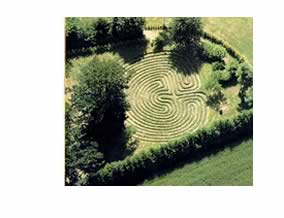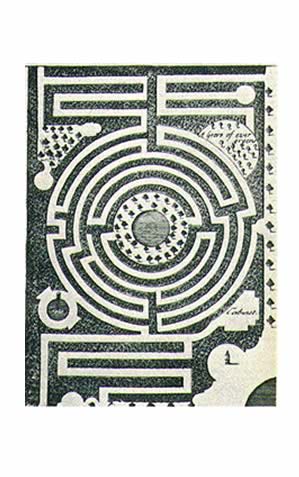|  MATTHEWS. MAZES AND LABYRINTHS 1922, chapters, illustrations and a selection of plates. MATTHEWS. MAZES AND LABYRINTHS 1922, chapters, illustrations and a selection of plates.
How are mazes to be drawn ?
How are they to be planned ?
 TO THE GARDEN MENU
TO THE GARDEN MENU
 MAGAZINE
COVER 1963 MAGAZINE
COVER 1963
TOP
ROW
The best
of modern mazes e.g.The Private Maze at Troy Farm, Somerton, a classical
turf maze.
CENTRE
Batty Langley's
design for a maze from New Principles of Gardening 1728
BOTTOM
•
18th century Dutch maze in garden at Gunterstien
•
illustration to Ovid's Metamorphosis in the Venetian
edition of 1570.
REFERENCES
Maze and
Labyrinth Images of the Maze
The Maze as sequence , typical features .
1. a beginning.
2. a directed unfolding (blind alleys - persuasive red herrings)
3. the culmination, the feature at the centre.
But untypical features,
4. the second culmination, getting out.
5. the possibility of never getting out.
Definitions .
Labyrinth, buildings partly or wholly subterranean containing a number
of chambers and intricate passages. In gardening, a labyrinth or maze
, an intricate network of winding paths.
The Landscape Maze
1. public places, the the maze on the playstow; "the quaint mazes
in the wanton green For lack of tread are indistinguishable" (A Midsummer
night's Dream). Cut turf patterns, in Pliny Natural History, popular in
medieval England as Troy Town, Julian's Bower, Maiden's Bower, Shepherd's
Race etc.
2. the maze in the private garden, Batty Langley, at Hampton Court ; Somerleyton
House; and the Labyrinth at Versailles; the cut turf extended in the forms
suggested by the Renaissance garden; the hedges should be of an even thickness
and lead to the centre where there is a seat or fountain. The Hampton
Court maze, laid out c1700 . Plans for a solution of the maze, keep your
hand on the right hand of the hedge. The Labyrinth at the Villa Worlitz,
the emblematic garden commemorating the central themes of Antiquity.
The Architectural Maze
the Chartres Labyrinth, to symbolise the earthly passage of the soul in
its search for salvation, is an exact geometrical equivalent (an in measurement
to the rose window representing the Last Judgement).See Crichlow below.
Reproduced Curtis p.37. The pilgrims visiting Chartres used the Labyrinth
as a substitute for the pilgrimage to Jerusalem. Zodiacal and geometric
pavements as cosmic lessons for the faithful. See also the Labyrinth at
Rheims Cathedral (16th c, destroyed 18th c) where 4 master masons were
named, one for each corner, with the archbishop at the centre. See Curtis
p.36
The architectural journey to the centre is at the heart of Freemasonry
(see Curtis). The Architect was closely associated with Daedelus. See
also Norman J.Johnson beneath
Isabelle de Beaufort's splendid environmental maze in the village of reignac
sur Indre in France. The routes are cut out of the growing crops and are
grown again the following year. " The Guardian July 19th 1997 reports
Ms de Beaufort saying, "We seem to have struck a sympathetic chord
with a public looking for something more peaceful and more thoughtful
than commercial theme parks. Photo by Frederic Reglain.
The Three Types of Labyrinth according to Umberto Eco- The Name
of the Rose.
1. The Greek Labyrinth "This kind does not allow
anyone to get lost: you go in, arrive at the centre, and then from the
centre you reach the exit." eg the labyrinth of Theseus,at the heart
is the Minotaur ; half man, half bull; the fruit of the unnatural liason
between Pasiphae (who had married Minos) and the Sacred White Bull, made
possible by Daedelus'cunning engineering. R.Garves I p.294. "Minos
consulted an oracle to know how he might best avoid scandal and conceal
Pasiphae's disgrace. The response was - Instruct Daedelus to build you
a retreat at Knossus. This Daedelus did and spent the remainder of his
lfe in the inextricable maze called the Labyrinth, at the heart of which
he concealed Pasiphae and the Minotaur. "Exacting some obscure revenge,
Minos demanded that every ninth year seven boys and seven girls be fed
to the Minotauar. The Hero and Professional Righter of Dreadful Wrongs,
Theteus pitied the parents of the sacrificed children and had himself
taken as one of the youths, disguising two effeminate youths of great
bravery and ingenuity as maidens. Theseus killed the Minotaur in the Labyrinth
and emerged using a length of thread for a passionate embrace from Minos'
new wife. A myth of sexual passion and labyrinthine doings. "if he
were not there the story would have no zest, it would be a mere stroll.
Terror is born, if it is born, from the fact that you do not know where
you will arrive or what the Minotaur will do. "Eco. Reflections.
2. The Mannerist Labyrinth ; "if you unravel it,
you find in your hands a kind of tree, a structure with roots, with many
blind alleys. There is only one exit, but you can get it wrong. You need
an Ariadne's thread to keep from getting lost. This labyrinth is the model
of the trial and error process.
3.
The Net or Rhyzome Labyrinth . "so constructed that every
path can be connected with every other one. OIt has no centre, no periphery,
no exit because it is potentially infinite. The space of conjecture is
a rhyzome space. The labyrinth of my Library is a rhyzome space.
Eco and Borges ; Literature and the Labyrinth; the labyrinth is a much
used metaphor for the human condition and for human intellectual speculation.
Umberto Eco, The Name of the Rose, the unravelling of the great labyrinth
by Adso and William. ("How beautiful is the world and how ugly labyriths
!")
See also J.L.Borges, the Argentinian poet, essayist and philosopher, see
volume of stories, Labyrinths. that Borges early work used two predominatn
symbols, the mirror and the search. The search implied the labyrinth.
" The universe which others call the Library is composed of an indefinite
and perhaps infinite number of hexagonal galleries, with vast airshafts
between, surrounded by very low railings. From any of the hexagons one
can see interminably, the upper and lower floors. The distribution of
the galleries is invariable.....The Library is unlimited and cyclical.
If an eternal traveller were to cross it in any direction, after centuries
he would see that the same volumes were repeated in the same disorder..."
Labyrinth and the Visual Arts
1. Picasso was particularly associated with the legend of the Minotaur,
in the late twenties, then in a series of images in all media, 1933, 4
and 5, eg Blind Minotaur, Dying Bull, the Minotauromachy etchings of spring
1935 culminating in Guernica 1937 .
2. George Tooker's Labyrinth paintings set in the New York Undergound
Railway passages. eg Subway. Also Tooker's Bureaucracy paintings, Government
Bureau, Landscape with Figures etc.
3. Robert Smithson, American sculptor, earth projects involving meanders,
mazes, spirals and broken circles.
4. Piranesi, Italian printmaker, the Carceri series of the 1740's, vast
labyrinths for prisoners.
The Labyrinth on Film ;
The Shining , directed by Stanley Kubrick, 1980, after the novel by Stephen
King. Kubrick replaces King's Topiary and Rocque Court with an external
garden maze as a metaphor for Jack Torrance's madness, and to mirror the
inner amaze of the hotel."Mazes, like games of chess (Kubrick's favourite
pastime) - combine design and deception, paths and choices, fate and cul-de-sacs
; all of which in variuous guises, play significant thematic roles in
almost every Kubrick film. Mazes are highly artificial human contrivances
whose orderly and complex sense of purpose involves a twofold conceptual
game in which the player must not only search for the centre but remember
how to get out."
see also Paths of Glory
and Barry Lyndon.
Other movies
that use the Labyrinth ;
Alain Resnais,
Last Year at Marienbad 1961.
Peter Greenaway
The Draughtsman's Contract.
see also
1. The Crazy House Mirror Maze from Orson Welles' The Lady from
Shanghai
2. Maidens to the heart of the mountain maze in Peter Weir's Picnic
at Hanging Rock .
3. At the heart of the maze in Tarkovsky's The Stalker
4. The influence of Escher in Ridley Scott's Labyrinth
.
5. Sewers as Labyrinth, post-war Vienna in Carol Reed's The Third
Man
The Four Great Labyrinths of Antiquity (from Pliny)
1. The Egyptian labyrinth as described by Herodotus,
a building surrrounded by a single wall, containing 1500 rooms above ground
and 1500 beneath ground. 2300 BC a cluster of sepulchral centres for kings
and sacred crocodiles.
2. The Cretan Labyrinth supposedly built by Daedelus
for Minos, the first ruler of all the Mediterranean; perhaps built near
Knossus, and associated with the legend of the Minotaur. Daedelus is the
mythic craftsman, designer, fabricator of ingenious devices (see below).
3. The Lemnian Labyrinth, built on the design of 1.
4. The Italian Labyrinth, a series of chambers in the
lower part of the tomb of Porsena at Clusium. The tomb led down to the
labyrinth from which it was particularly difficult to find the way out.
Film Sequences
BOOKLIST
T.H.Garver, George Tooker, Rizzoli, NY 1977
Geoffrey Grigson, The Shell Country Alphabet , Joseph
London 1966 (under Mazes)
Robert Graves, The Greek Myths, 2 vols, Penguin Harmondsworth,
1966 (paperback)
Michael Ayrton, The Maze Maker ,an invented biography of Daedelus,
Longmans Green London 1967.
Keith Crichlow, "The Chartres Maze", Architectural Assocation
Quarterly, vol 5 no2, 11.20.
The myth of the Minotaur also to be seen in Euripedes,
Hippolytus, in the works of Ovid ( Metamorphosis), Plutarch, Virgil and
Catullus.
T.A.Nelson, Kubrick, Inside a Film Artist's Maze , Indiana
Univ.Press Bloomington, 1982 (Chapter on The Shining).
Umberto Eco, The Name of the Rose, Picador,
London 1983.
Umberto Eco, Reflections on The Name of the Rose, Secker
& Warburg London 1983.
J.L.Borges, Labyrinths, Penguin Harmondsworth 1983, see
the following stories, "The Library of Babel", "The Garden
of Forking Paths", and "The Circular Ruins".
Greg Bright's Hole Maze, Fontana Paperback London 1979
J.S.Curl, The Art and Architecture of Freemasonry, Batsford
London 1991 (Chapter on the Elysian Fields).
Norman J.Johnson, Cities in the Round ,University of
Washington Press, Seattle and London, 1983.
|

















